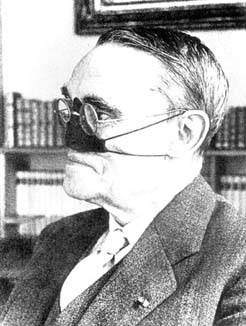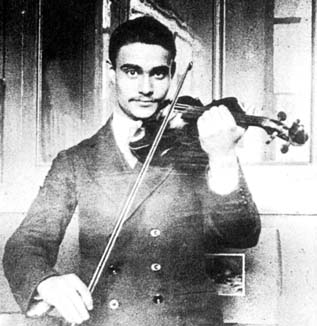<Back to Index>
- Mathematician Gaston Maurice Julia, 1893
- Composer Jakob Ludwig Felix Mendelssohn Bartholdy, 1809
- Prime Minister of the United Kingdom Robert Arthur Talbot Gascoyne Cecil, 3rd Marquess of Salisbury, 1830
PAGE SPONSOR


Gaston Maurice Julia (February 3, 1893 – March 19, 1978) was a French mathematician who devised the formula for the Julia set. His works were popularized by French mathematician Benoît Mandelbrot, and the Julia and Mandelbrot fractals are closely related.
Julia was born in the Algerian town of Sidi Bel Abbes, at the time governed by the French. During his youth, he had an interest in mathematics and music. His studies were interrupted at the age of 21 years old, when France became involved with World War I and he was conscripted to serve with the army. During an attack he suffered a severe injury, losing his nose. After many unsuccessful operations to remedy the situation, he resigned himself to wearing a leather strap around the area where his nose had been for the rest of his life. Julia gained attention for his mathematical work after the war when a 199-page article he wrote was featured in the Journal de Mathématiques Pures et Appliquées, a French mathematics journal. The article, which he published during 1918 at the age of 25, titled "Mémoire sur l'itération des fonctions rationnelles" described the iteration of a rational function. The article gained immense popularity among mathematicians and the general population as a whole, and so resulted in Julia's later receiving of the Grand Prix de l'Académie des Sciences. Despite his fame, his works were mostly forgotten until the day Benoît Mandelbrot mentioned them in his works. Julia died in Paris at the age of 85.
Gaston Julia's
parents were Delorès Delavent and Joseph Julia. Two generations
before, the family had left the Spanish Pyrenees to become established
in Algeria after the French colonised the area. Joseph Julia, who was a
mechanic, was working in Sidi-bel-Abbès when his son was born.
Gaston became interested in mathematics and music when he was young. He
entered school when he was five years old, and was taught by Sister
Théoduline. She gave young Gaston certain principles which he
followed throughout his life, in particular to always aim at being top
in everything he did. She also encouraged Gaston's mother to provide
financial support to allow her son to have a good schooling, something
that was very difficult to achieve given that the family were very
poor. Gaston studied with the Frères des Écoles
Chrétiennes (Brothers of the Christian Schools) from the age of
seven. His outstanding abilities were quickly spotted, and his teachers
encouraged Gaston's parents to try to get a scholarship to allow him to
study at high school. In 1901, when Gaston was
eight, the family moved to Oran, a city on the Mediterranean coast in
northwest Algeria 70 km north of Sidi-bel-Abbès. There Gaston's
father earned his living repairing agricultural machinery. Gaston
entered the Lycée in Oran, and his parents wanted him to begin
his studies in grade 5. However, the teachers pointed out that pupils
in that grade had already studied German for one year while Gaston had
no knowledge of the language. However, Gaston requested that they give
him a month in the class to prove that he could catch up. Learning on
his own from books, he soon caught up and was allowed to remain in this
class. By the end of one year he was the best pupil in German as well
as in every other subject that he studied. He graduated with
distinction in the baccalaureate examinations in science, modern
languages, philosophy and mathematics.
Julia won
a scholarship which allowed him to go to Paris and spend the year
1910-11 at the Lycée Janson-de-Sailly where he took classes in
higher mathematics. Despite his outstanding abilities, Julia did not
find life easy. First, he was still young and had left the familiar
country in which he was brought up for the very different life in
France. Second, he contracted typhoid fever before he had even begun
his studies and was taken to hospital. It was November of 1910 before
he was well enough to embark on a course which normally took two years
but which he had to complete in the remaining eight months. Despite
these difficulties he was still able to reach a higher standard than
any other student. Somehow, he was also able to continue his interest
in music, playing on a violin his mother had given him, and it was
during this time that he fell in love with the music of Bach, Schubert,
and Schumann. Throughout his life these continued to be his favourite
composers. He sat the entrance examinations for the École
Normale Supérieure and the École Polytechnique and was
placed first in both entrance examinations. He could choose either
university but decided to enter the École Normale on the grounds
that it was the stronger of the two establishments for mathematics.
Entering the École Normale Supérieure in 1911, Julia had just completed the examinations for his first degree in mathematics when political events in Europe interrupted his studies. Matters came to a head in July 1914 with various declarations of war, and on 3 August Germany declared war on France. Events had been moving quickly and Julia received his call up papers one day later. He trained with the 57th Infantry Regiment at Libourne and was soon made a corporal, then a sub-lieutenant. He saw action on the western front with the 144th Infantry Regiment when sent to the Chemin des Dames ridge. Kaiser Wilhelm II of Germany had his birthday on 27th January and the German troops wished to mark the occasion with successes. Accordingly, on 25 January they launched a strong attack on the French lines where Julia and his men had just arrived. The following is a report of what happened to Julia that day:-
January 25, 1915, showed complete contempt for danger. Under an extremely violent bombardment, he succeeded despite his youth (22 years) to
give a real example to his men. Struck by a bullet in the middle of his
face causing a terrible injury, he could no longer speak but wrote on a
ticket that he would not be evacuated. He only went to the ambulance
when the attack had been driven back. It was the first time this
officer had come under fire.
Many
on both sides were wounded in the action called the 'attack of the
Creute farm' in which the Germans captured the remaining allied
positions on the plateau. Julia's injury was an extremely painful one
and many unsuccessful operations were carried out in an attempt to
repair the damage. Eventually, in 1918, he resigned himself to the loss
of his nose and he had to wear a leather strap across his face for the
rest of his life. Between these painful operations he had carried on
his mathematical researches often in his hospital bed. He undertook
research at the Collège de France, beginning in 1916, and in
1917 he submitted his doctoral dissertation Étude
sur les formes binaires non quadratiques à
indéterminées réelles ou complexes, ou à
indéterminées conjuguées. The examiners of his thesis were Emile Picard, Henri Lebesgue and Pierre Humbert, with Picard as president of the examining committee.
In 1918 Julia married Marianne Chausson, one of the nurses who had looked after him while he was in hospital. Marianne was the daughter of the romantic composer Ernest Chausson, who had died in 1899 in a freak accident on his bicycle. Gaston and Marianne Julia had six children: Jérôme, Christophe, Jean-Baptiste, Marc, Daniel, and Sylvestre.
When only 25 years of age, Julia published his 199 page masterpiece Mémoire sur l'iteration des fonctions rationelles which made him famous in the mathematics centres of his day. The beautiful paper, published in Journal de Math. Pure et Appl. 8 (1918), 47-245, concerned the iteration of a rational function f. Julia gave a precise description of the set J(f) of those z in C for which the nth iterate f n(z) stays bounded as n tends to infinity. He received the Grand Prix of the Academy of Sciences for this remarkable piece of work.
In November 1919 he was invited to give the prestigious Peccot Foundation lectures at the Collège de France and was appointed as Maître de Conférences at the École Normale Supérieure. At the same time he was appointed répétiteur in analysis at the École Polytechnique, examiner at the École Navale, and professor at the Sorbonne. This appointment to a professorship at the Sorbonne came without a specific chair, but in 1925 he was named to the Chair of Applications of Analysis to Geometry at the Sorbonne. In 1931 he was appointed to the Chair of Differential and Integral Calculus, then in 1937 he was appointed to the Chair of Geometry and Algebra at the École Polytechnique when Maurice d'Ocagne retired.
Seminars were organised in Berlin in 1925 to study Julia's work on iteration and participants included Richard Brauer, Heinz Hopf and Kurt Reidemeister. H Cremer produced an essay on his work which included the first visualisation of a Julia set. Although he was famous in the 1920s, his work on iteration was essentially forgotten until Benoit Mandelbrot brought it back to prominence in the 1970s through his fundamental computer experiments. However, Julia was very active mathematically over a wide range of different topics which is perhaps best summarised by looking briefly at the six volumes of his collected works which were published between 1968 and 1970 edited by Jacques Dixmier and Michel Hervé. Of course the volumes were published before Julia's death so he was able to write the Preface to the volumes himself. In addition to the Preface, Volume 1 contains a list of Julia's 232 publications from 1913 to 1965. These 232 publications consist of 157 research papers, 30 books, and 45 articles on the history of science or miscellaneous topics.
Volume 1 contains works on iteration and its applications. Volume 2, in three parts, consists of articles on (i) J points of functions of one variable, (ii) J points of functions of several variables, and (iii) Series of iterates. Volume 3 contains four parts: (i) Functional equations and conformal mapping; (ii) Conformal mapping; (iii) General lectures; and (iv) Isolated works in analysis on Implicit function defined by the vanishing of an active function, and on certain series. Volume 4 is again in four parts: (i) Functional calculus and integral equations; (ii) Quasianalyticity; (iii) Various techniques of analysis; and (iv) Works concerning Hilbert space. Volume 5 contains works on (i) Number theory; and (ii) Geometry, mechanics, and electricity. Volume 6 contains Julia's miscellaneous writings.
What about the 30 books? Let us mention Eléments de géométrie infinitésimale (1927), Cours cinématique (1928), and Exercices d'Analyse (4 vols) (1928-38), the classic Principes Géométriques d'Analyse (1930), a second volume of Principes Géométriques d'Analyse and another classic text, Introduction Mathématique aux Theories Quantiques, in two volumes, the first in 1936 and the second in 1938. Further books by Julia include L'espace hilbertien (1949) and Eléments d'algèbre (1959).
Julia received many honours for his outstanding mathematical contributions. He was elected to the Academy of Sciences on 5 March 1934, filling the place left vacant by the death of Painlevé in the previous year. He was elected President of the Academy in 1950. He was also elected to the Upsal Academy in Sweden, the Pontifical Academy of Rome, and many other European Academies. He was also President of the French Mathematical Society. In 1950 he was made an officer of the Légion d'Honneur.